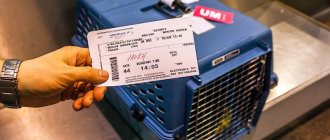Cats are considered homebodies. But we made them this way, teaching them to sit within four walls. Cats of active owners who have no one to leave their pet with travel with their owners, even on an airplane. Today we will talk about the intricacies of air transportation of tailed animals.
Cats can be carried on planes. Some airlines allow you to do this in the cabin with the owner, others only in the cargo hold. The conditions of transportation are dictated by the country where you are going. For example, in France you can carry a pet in your arms, but in the UAE - only in the cargo compartment: for violating the rules, the passenger and the airline pay a fine. Therefore, the first thing you need to do is find out the rules of a particular country for importing pets, the second thing is to check with the airline about its rules. After all, if you do not comply with the requirements, you risk losing your pet (it can be confiscated at the border) or pay a huge fine, but the animal will still not be allowed across the border.
Article continues after advertisement
You should familiarize yourself with the rules for importing a pet into the country on the website of the embassy or consulate, which indicates what documents will be needed. Most often this is:
- an international veterinary passport correctly filled out in English;
- subcutaneous microchip;
- certificate of satisfactory health of the pet, issued at a state clinic (valid for 3 days from the date of issue);
- certificate with a blood test for rabies (for some countries);
- For a number of countries, you need a license to export an animal from a felinological club (if it is of breeding value) or a certificate stating that the animal is not of breeding value;
- For a number of countries, an import certificate is required, which lists all measures to prepare the animal for travel.
Some states require additional documents, the list of which is agreed upon in advance. These documents will be asked not only when crossing the border, but also at the airport before registering your pet for a flight, because... The airline doesn't want to pay the fine.
Also inquire whether quarantine is required when importing animals into the country. In many states, the animal is kept in quarantine from several days to six months. If so, then when going on a week-long vacation, it is better to place the cat somewhere rather than take it with you.
To prepare your pet for a flight, you need not only a microchip, but also all mandatory vaccinations no less than 30 days before the trip, and no earlier than 1 year before the trip. That is, you won’t be able to get off the ground in 2 days. Please note that the chip must be inserted before you get vaccinated.
You must notify the carrier in advance that you are planning to fly with a pet. This is important because airlines usually have quotas for carrying animals on one flight and there may simply not be enough space for you.
Please note that you will have to pay extra to transport your cat. Each airline has its own tariffs. But abroad these are quite significant amounts, which can reach up to 500 euros.
Sometimes plans to bring a pet with you must be reported in advance to the authorities of the country of arrival, who must issue permission for this. For example, in the Emirates, this procedure is similar in bureaucratic subtleties to obtaining a visa.
Proper Carrying
A cat carrier on an airplane must meet all airline requirements. Each has its own rules, so if you are combining two companies with different requirements, you will need to purchase two carriers.
Article continues after advertisement
Requirements relate to weight, size and material of the carrier. So, if the owner is transporting an animal weighing less than 8 kg together with the carrier, it can be taken into the aircraft cabin. If desired, you can put two cats in the carrier. But the requirements for the total weight of the container must still be met. Containers weighing more than 8 kg are sent to the cargo compartment.
Size requirements state that the cat or cats must fit comfortably in the container, standing up to their full height and lying down without constraint. That is, the carrier must be spacious, but at the same time fit into the restrictions set by the airline.
Some carriers allow fabric bags, but most require them to be plastic or metal.
The carrier must have a reliable door with a good latch that the animal cannot open, and a rigid, waterproof bottom. The carrier provides ample air holes. Typically, the main ventilation is provided by the door.
Some airlines, in addition to these criteria, require the use of carriers from a specific brand. This happens rarely. But all companies prohibit the transportation of animals in homemade bags and carriers.
Not only airlines, but also airports can make their own requirements, so read the rules of the airports of departure and arrival in advance.
As for the internal carrying structure, a design with a built-in feeder and drinker is desirable. Plus, cat owners praise carriers that are equipped with a special door on the roof so that they can open and pet the cat: this way the pet will feel supported all the time.
Cats get scared when they are carried to an unfamiliar place, especially one as noisy as an airport. Therefore, some owners buy a special carrying case that remains open on one side. This way the pet hears fewer sounds and sees almost nothing, and therefore feels more or less protected.
Story No. 4
I fly often and usually arrive at the airport an hour before departure.
But when I had to take the cat, I arrived about three hours in advance, and of course I didn’t regret it. In addition to the usual check-in for the flight, there was also a veterinarian examination and payment for transportation of the cat. And these are quite long queues. Alexey M. , flew with a cat from Novosibirsk to Moscow (cat’s age is 6 years)
Alexey is great. If you have to fly with a cat, leave the house earlier. It will take time to visit the veterinary center at the airport, where the cat will be issued a boarding pass, then check in yourself, then pay for the transportation of the animal at the airline counter, and then, if the cat is flying in luggage, contact an airline representative to have the carrier sealed and handed over for loading. on the plane. The seal is needed to prevent the cage from opening upon impact, during takeoff and landing, or other situations.
The line is long not because everyone is standing with cats, but because a cat is considered excess baggage. And all passengers with such luggage stand in one line.
Toilet while traveling
During the trip, the cat will also go to the toilet in a carrier. The tray is not placed in the carrier, but an absorbent napkin is placed on the bottom. The trouble is that not all cats can go to the toilet so easily: some begin to rush around the cage, begging to be let out. But sooner or later, if it’s really hot, everyone still gives up.
Before departure, it is better not to feed the cat heavily, so as not to have to clean up the shit. You can feed during the flight, but not much. But access to water must be constant.
Article continues after advertisement
Final advice
In addition to a blanket, you can relieve your cat’s stress with a spray that imitates the smell of cat glands. They use them to mark their territory. Not to be confused with the stinking glands of males! This spray does not smell of anything. Spray the inside of the carrier and your cat will become accustomed to the familiar smell. Also, upon arrival at a new place, treat the corners of the house for the same effect.
Helpful tips: try to organize a toilet and food for your cat at the end point of your trip in advance.
This is the first thing he will need, and it would be nice if they were already ready. You can take his favorite toy with you or put him straight into the carrier. And most importantly: most likely, in the warm and dark trunk of the plane, under the uniform hum of the engines, the cat will simply sleep through the entire flight. Alexey K. , flew with a cat from Vladivostok to Moscow (cat age 11 years, breed “red nobleman”)
Preparing a cat for flight
Any trip causes stress for an unprepared cat. If she is not accustomed to walking outside and riding public transport, she will have a hard time. Most often, pets freeze and remain silent when they are afraid. But they might start screaming. Everything is individual. The owner may not even notice the problem, and in the meantime, the cat’s body, if the trip is long, will experience overload, become exhausted, and its immunity will drop. To prevent this from happening, you need to start accustoming your cat to travel several months in advance.
First, buy a good carrier. Introduce the animal to it. It is advisable to place it open in the middle of the room so that the pet can enter on its own. After you have seen that the cat is already familiar with the carrier, you can try going outside with it for 5 minutes. The next day, give the cat a rest, and the next day go outside again. This should be done for a couple of weeks, increasing the walking time. Moreover, you need to start from deserted places, and then you can go, for example, to a park. When the cat gets comfortable, he will want to get out of the carrier. You must first open it and place it next to you. The cat must have a harness so that you can control its movement. It takes 2-3 months to accustom a cat to walks so that he feels comfortable outside the home. Read more about how to train your cat to go for walks.
It is not recommended to sedate your cat before a flight without the advice of a veterinarian, as this will lead to a decrease in blood pressure, which is dangerous during the flight. But you can use calming sprays with pheromones and matatabi grass.
Small kittens can be injected with a drug that increases immunity in advance. But kittens without vaccinations will only be allowed to be transported with a nursing mother.
On the day of the flight, behave calmly: the animal feels the emotions of the owner and sometimes gets nervous only because the owner himself is in an unbalanced state.
Flying is stressful for an animal
My friend moved to Moscow from a small provincial town. A year later he returned home to pick up his beloved dog. The flight with her turned out to be very expensive; a friend even sold his computer for the dog’s air ticket. But the dog did not survive the flight well. When she was brought home, she was very frightened and did not recognize her owner. The veterinarian said that the animal had lost its mind due to stress and could not be helped.
If you love your animal very much, do not take it with you. Find a foster home or a new owner. As a last resort, take it by train and ask your veterinarian about anti-stress medications.
What to take on the road
If you are flying on vacation with a cat, then, in addition to the carrier with the toilet, you will have to take other things:
- documents for the cat;
- food and water;
- clothes for the cat (if she is cold);
- absorbent toilet wipes;
- wet wipes (in case your pet gets dirty);
- cat tablets for diarrhea and vomiting (if it suddenly catches);
- anti-flea collar on the cat (or it is preventively treated against fleas and ticks with drops);
- an antihistamine (in case your seatmate is allergic to cats).
Personal experience
Maria Dolgopolova flew around Russia with her dog Glasha
The dog is only a year old, and we flew around Russia several times: from Moscow to Sochi and Volgograd and back. We flew Pobeda, and everything went very smoothly, despite the fact that everyone scolded it. With Pobeda, the main thing is to find out all the nuances before the flight and follow them.
Dog Glasha at the airport
Transporting a dog costs about 2500 RUR, ours weighs less than 8 kg, which means it can be carried in the cabin. The funny thing is that our Glasha tolerates trips in vehicles as poorly as possible: she worries if passengers start getting off the bus, but we stay, and doesn’t like it when new ones get on; She gets motion sickness, and during the trips we've had, she's even learned to vomit into a glass. But on the plane, this is the best passenger: he lies calmly in his carrier, and if he gets tired, he climbs onto my lap, lies down to take a nap, and the whole plane is touched. But, of course, she can be banned from doing so.
What to do at the airport
It will take additional time to register your pet. First you need to find a veterinary control point where the cat's documents and health status will be checked. If the cat is clean and without signs of illness, it will pass the test. Typically, veterinary centers are located near passenger check-in counters.
After passing veterinary control, you will receive an international veterinary certificate in exchange for a health certificate, which you issued 3 days before at the state veterinary clinic. After veterinary control, go to the passenger check-in counter.
When waiting for a flight at the airport, the animal can be released from its carrier, but only if it is wearing a leash. The fact is that the pet may get nervous and run away. There were cases when cats escaped and hid in the bowels of the airport.
Article continues after advertisement
How to prepare documents for taking a cat abroad
You should find out in advance about the required document processing procedures in a particular case at the consulate (on the consulate website) of the country to which you are traveling with your cat. The owner of the animal is responsible for compliance with the legislation of the country into, from or through the territory of which the transportation is carried out.
Cats that have not been vaccinated against rabies are prohibited from being imported into most countries. Country requirements may change; please check to ensure they are up to date before travelling. If you plan to visit several countries or travel in transit, you need to find out the veterinary and sanitary requirements of all countries.
Another necessary condition for importing an animal into most countries is microchipping. The process of inserting the chip is painless; the veterinarian inserts it under the skin of the cat’s withers. Each chip has an individual number, which will be entered in the cat’s veterinary passport and in the international Animal-ID database.
Vaccination against rabies is a mandatory requirement for traveling with a cat abroad. The date of administration of the rabies vaccine should not precede the date of implantation of the chip. If the animal has already been vaccinated this year, but microchipping was carried out only now, the rabies vaccination will have to be done again.
At the station for the control of animal diseases (SABD) - these are, as a rule, state veterinary clinics, the pet will be prepared for the trip: the necessary treatments will be done (in particular, against echinococcosis - tapeworms), microchipping, vaccination (against rabies and panleukopenia - plague) and make the necessary notes in the international veterinary passport. The requirements for vaccination in most countries vary; the average approach is that it should be carried out no later than 21 days before crossing the border. Treatment against echinococcosis, for example, for importing an animal into the European Union, is carried out no earlier than 120 hours and no later than 24 hours before the flight.
To cross the border, a vaccinated animal that is prepared for travel only needs to obtain an international veterinary passport in advance.
How to behave in the cabin of an airplane?
It is not advisable to let your cat out of the container while traveling, as it may behave inappropriately. At the same time, it is important for the animal not to lose contact with the owner, so hold the carrier in your arms and talk gently to the pet, opening the lid so that the animal can stick its head out. Or, on the contrary, place the container on the floor, covering it with something. Cats love secluded places and respond well to silence and darkness. Perhaps this will even make it easier for the animal to calm down.
During takeoff and landing, the container with the animal must be placed under the seat in front so that it is firmly secured. For safety reasons, it is allowed to do this for the entire flight, because... turbulence possible.
People with animals are not allowed to sit in the seats near the emergency exit.
Carrying a cat in the luggage compartment
Most cats tolerate just such a voyage normally. At least the compartment is quieter than the airplane cabin. Moreover, if the trip is a long distance, the cat will simply be uncomfortable in a small carrier. And in his luggage he has a whole enclosure. In addition, the enclosure can be covered on all sides with fabric, which will close the cat from the outside world.
Sometimes traveling in the hold is unavoidable: if the cat is too large or if the airline and host country have such a rule. In this case, make sure that the animal does not freeze (you can dress it in a cat sweater, and place a warm bedding at the bottom of the carrier, although luggage compartments with animals are heated) and less worried (place the carrier in a fabric cover).
But, if you have a choice, we do not recommend sending your pet in the luggage compartment, especially if it is flying on an airplane for the first time, because... you don’t know how his body will react to this. The first time, it is advisable to monitor his condition and, if necessary, provide assistance. At the same time, if this is not possible, there is no need to worry too much: cats tolerate flights well in any conditions. There are even cases when they climbed into the suitcases of their owners and traveled enormous distances in their luggage.
However, you should be aware that there are airlines that are careless about pets in luggage. There were even cases of death. So it’s better to check with the airline in advance. Sometimes cruelty to animals becomes a reason to choose another carrier.
Was the event difficult or easy?
Traveling by plane is extremely stressful for your territorial pet. He was not just “pulled out” from his usual environment, where he had established his life and learned every little detail better than his owner, but was also subjected to unusual physiological stress: pressure changes, turbulence, unrecognizable noises, odors. Some animals - about 7-12% of them - quickly adapt to changes in the situation and what is happening, but the majority still experience great fear. Its result may be:
- Frequent urination;
- Delay in going to the toilet;
- Lethargy and lethargy;
- Tremor of the body and limbs (the main symptom of fear);
- Lack of reaction to things that before the move caused delight in the pet;
- Refusal to eat;
- Aggressive behavior;
- Reluctance to make contact.
If a cat exhibits similar symptoms after a flight, it means that the flight was painful for the animal. In 89.6% of cases, the apathetic state disappears gradually after 2-5 days. It all depends on the degree of stress received, but whatever it is (high or low), he will need the help of his owner.











